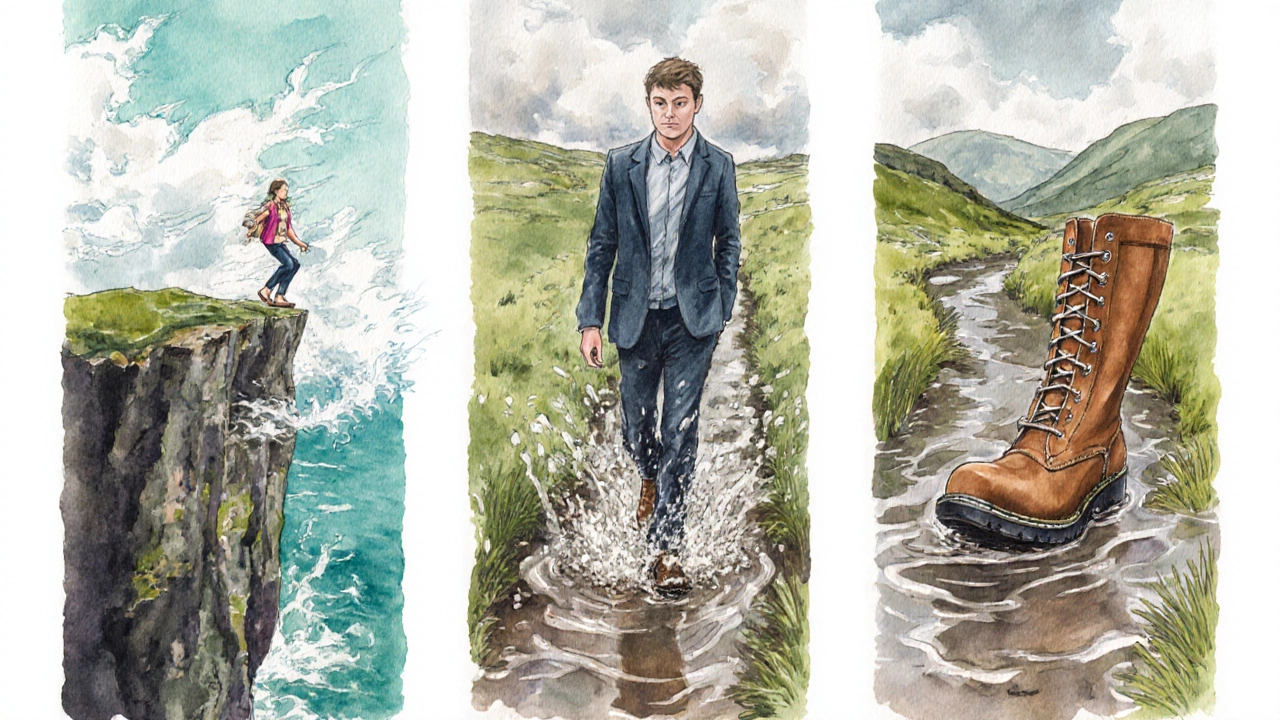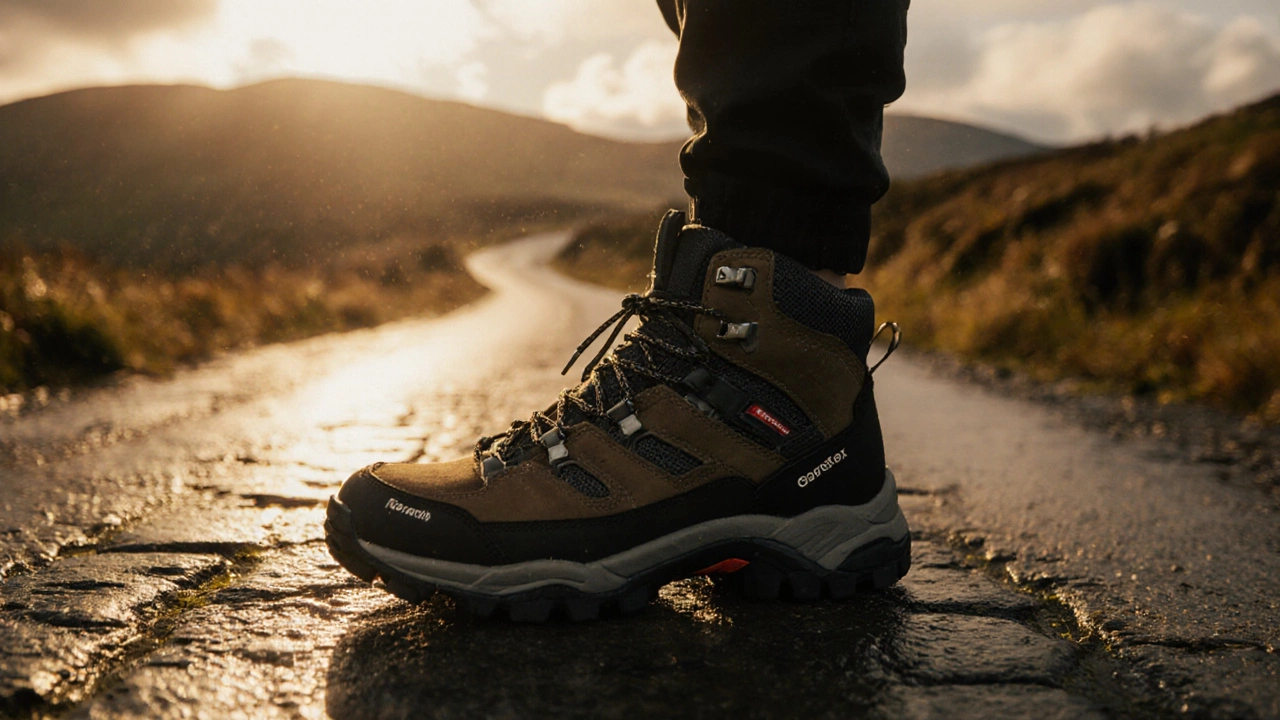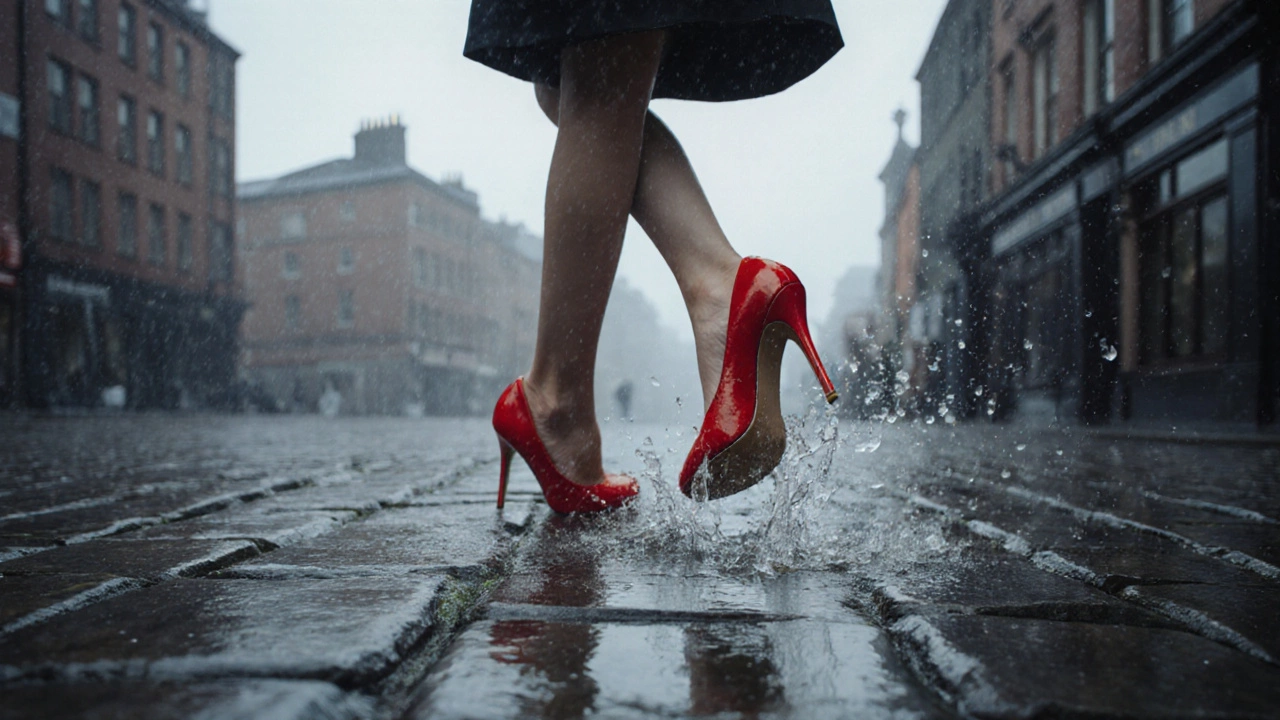Shoe Type Selector for Irish Conditions
Select a shoe type below to learn why it's problematic in Ireland and what to choose instead.
High Heels
Limited grip, ankle strain
Flip Flops
Thin sole, no support
Non-Waterproof Boots
Absorb moisture, deform
Cheap Leather Shoes
Crack in humidity
Platform Shoes
Unstable on uneven ground
Slip-On Sneakers
Foot fatigue on long walks
Synthetic Dress Shoes
Non-breathable, slippery
Selected Shoe Information
Select a shoe type above to see details about why it's unsuitable for Irish conditions and what to choose instead.
Walking the streets of Dublin on a rainy morning or hiking the Wicklow Mountains in a drizzle can turn a simple stroll into a test of endurance if you’re wearing the wrong footwear. Knowing shoes to avoid can save you from sore feet, slips, and wasted money, especially when Ireland’s unpredictable weather and historic cobblestones are part of everyday life.
Key Takeaways
- Avoid footwear that isn’t waterproof or lacks good grip on wet stone.
- High heels and flimsy flip‑flops increase the risk of ankle injuries on uneven terrain.
- Cheaply made leather or synthetic shoes often break down quickly in damp conditions.
- Look for sturdy soles, breathable linings, and proper arch support for Irish streets and countryside.
- Invest in versatile, weather‑ready alternatives like leather boots with Gore‑Tex or supportive trainers.
Why shoe choice matters in Ireland
From the slick cobbles of Temple Bar to the rain‑slicked trails of the Dingle Peninsula, Ireland offers a mix of urban and rural surfaces that demand specific shoe characteristics. The Irish climate delivers an average of 165 rainy days a year, meaning moisture‑resistant materials are not a luxury-they’re a necessity. Additionally, many historic towns still feature uneven paving, while the countryside brings peat bogs and slippery riverbanks.
Choosing the wrong pair can lead to frequent slips, blisters, and even long‑term posture problems. Local podiatrists in Cork and Galway frequently report an uptick in plantar fasciitis cases linked to poor arch support during the winter months.

Common shoe types to avoid
Below is a rundown of footwear that typically fails under Irish conditions. Each entry includes a brief definition, why it’s risky, and a local example of where it could cause trouble.
High heels are shoes with a raised heel, often over 5cm, designed for formal occasions. They concentrate pressure on the forefoot and provide limited traction on wet surfaces. Walking the slick steps of Trinity College in a pair of stilettos can lead to ankle twists, especially after a sudden downpour.
Flip flops are open‑toed sandals held on the foot by a Y‑shaped strap. They offer minimal support and a thin sole that slides on wet stone. A tourist wearing cheap flip‑flops on the Cliffs of Moher might lose footing on the sea‑sprayed paths.
Non‑waterproof boots are leather or suede footwear without a sealed membrane. When soaked, the material swells, the stitching loosens, and the foot gets damp, leading to cold feet and blisters. Ideal for a dry city stroll but disastrous on the soggy fields of Killarney National Park.
Cheap leather shoes refer to low‑cost dress shoes made from thin, untreated leather. They crack, warp, and lose shape quickly in humidity. Many office workers in Limerick buy budget shoes for a meeting, only to find they disintegrate after a week of rain.
Platform shoes are footwear with a thick sole that raises the entire foot. The added height shifts the centre of gravity, making balance harder on uneven cobbles. A night out in Belfast’s Cathedral Quarter while wearing platforms can become a balancing act after a sudden drizzle.
Slip‑on sneakers with poor arch support are casual shoes lacking insoles or structured midsoles. They allow the foot to flatten, increasing fatigue on long walks. A weekend trek through the Burren in such sneakers often ends with sore arches by the day’s end.
Synthetic dress shoes are formal shoes made from plastic‑based materials. They rarely breathe, trap moisture, and become slippery when wet. Attending a wedding in a synthetic pair during an autumn shower can result in sloshing feet and uncomfortable heat.
How to spot bad shoes before you buy
- Check the sole material: Rubber with deep treads offers grip on wet stone, while smooth leather soles slide easily.
- Feel the cushioning: Press the heel and forefoot; a firm yet responsive feel indicates good shock absorption.
- Inspect the stitching: Double‑stitched seams stay intact in humid weather; fragile glue‑only joins often peel.
- Test water resistance: Lightly damp a cloth and run it over the interior. If the material feels soggy, the shoe will stay wet.
- Assess arch support: Try an in‑store walk on a sloped surface; your foot should feel cradled, not flat.

Better alternatives for Irish life
Below is a quick guide to footwear that thrives in Ireland’s climate and terrain. Each alternative addresses a specific flaw listed above.
| Avoided Shoe | Why it Fails | Recommended Alternative | Key Benefit |
|---|---|---|---|
| High heels | Limited grip, ankle strain | Chunky‑heeled ankle boots | Stable heel, waterproof leather |
| Flip flops | Thin sole, no support | Water‑proof EVA sandals | Grippy tread, quick‑dry material |
| Non‑waterproof boots | Absorb moisture, deform | Gore‑Tex lined hiking boots | Breathable yet fully sealed |
| Cheap leather shoes | Crack in humidity | Full‑grain leather brogues | Durable grain, natural water repellency |
| Platform shoes | Unstable on uneven ground | Chunky‑sole trainers | Even weight distribution, good traction |
| Slip‑on sneakers with poor arch | Foot fatigue on long walks | Orthopedic casual shoes | Built‑in arch support, cushioned footbed |
| Synthetic dress shoes | Non‑breathable, slippery | Leather lace‑ups with rubber sole | Breathable, firm grip |
Maintaining your Irish‑friendly shoes
Even the best shoe can falter without proper care. Follow these simple steps to extend lifespan:
- Brush off mud after every walk in the Wicklow Mountains; let the shoes air‑dry away from direct heat.
- Apply a waterproofing spray designed for leather or suede at least once a month during the rainy season.
- Replace worn‑out soles promptly-once the tread depth reaches 3mm, slips become more likely.
- Rotate between two pairs of work or hiking boots to let each dry fully between uses.
- Store shoes on a breathable shoe rack, not in sealed plastic bags, to prevent mold growth.
Frequently Asked Questions
Can I wear stylish high heels in Dublin during summer?
You can for brief indoor events, but avoid rain‑soaked streets. Opt for low, chunky heels with rubber soles that offer better grip and stability.
Are waterproof trainers necessary for city commuting?
Yes. Irish city sidewalks become slick quickly. A trainer with a waterproof membrane and deep tread will keep your feet dry and reduce slip risk.
What budget brands offer reliable walking shoes for the Irish weather?
Brands like Clarks, Skechers, and Irish‑made Francis Shoes provide mid‑range models with waterproof uppers and rubber soles that hold up well without breaking the bank.
How often should I replace my hiking boots in Ireland?
Typically every 500-800 kilometres of rugged use, or sooner if the sole tread wears down to less than 3mm, or the waterproof membrane shows signs of leakage.
Is it worth investing in custom orthotic insoles for everyday shoes?
For anyone who walks long distances on uneven cobblestones or hikes boggy trails, custom insoles can prevent plantar fasciitis and improve overall comfort.
